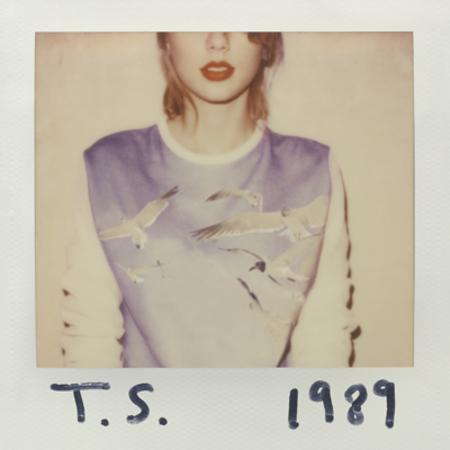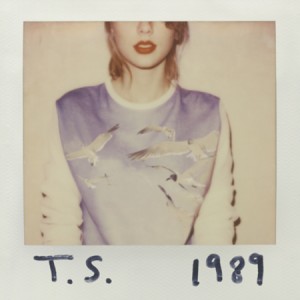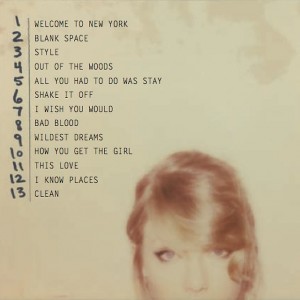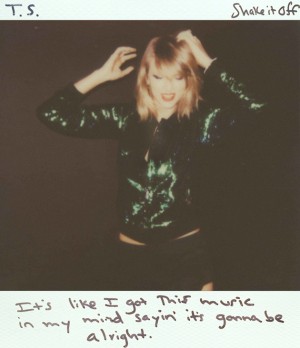Taylor Swift 1989: Full Album Review

December 9, 2014
Almost every ear across the globe has heard a song by Taylor Swift, who has recently taken the final leap into the pop genre. She cut away her long, golden hair, put her acoustic guitar in its case, and picked up her bags for the big apple -a place she had taunted a critic on “Mean” in 2010 saying, “Someday I’ll be living in a big ol’ city”. Now she is making New York her stage.
Swift’s fifth album, 1989, was released October 27. According to Billboard.com, 1989 has the largest sales week for an album since June 2002. 1989 debuted atop the chart a week early, selling 285,000 copies after it was released on a Friday, giving the album only three days of sales in its chart bow.
In 1989, one will find a number of country songs, R&B, and rap singles; that number is zero. Of the thirteen singles on Swift’s album, each one of them emulates her idea of pop music; 1989 was inspired by the 1980s when pop was less overtly hybrid and mixed with other genres.
“For the last few years, I’ve woken up every day not wanting, but needing to write a new style of music. I needed to change the way I told my stories and the way they sounded. I listened to a lot of music from the decade in which I was born and I listened to my intuition that it was a good thing to follow this gut feeling. I was also writing a different storyline than I’d ever told you before,” Swift said in a letter from gomoxie.com.
Synths -an electronic musical instrument that generates electric signals- pulsating bass, and drums drive the album forward with her vocals in lieu of her usual talky manner. Though the music itself is less than to be desired, listeners can connect to the reawakened Swift on a new plane: because she still sounds like that awkwardly imperfect, eccentric, and passionately emotional girl even without her iconic acoustic and blatantly obvious pictures she paints.
1989 itself is a mix of bright and upbeat pop-songs to slow and mysterious. It differs from Swift’s earlier album in storytelling from speaking of her experiences to conveying a neutered, broader field of struggles of romance and starting anew.
Opening 1989 is her single “Welcome To New York”, a tribute to the city she was so sure she would never move to:
“When we first dropped our bags
On apartment floors
Took our broken hearts
Put them in a drawer
Everybody here was someone else before
And you can want who you want
Boys and boys and girls and girls”
She physically leaves the world of country in Nashville and immerses herself in the bright lights of New York. There she literally has a new beginning where she can be someone new; to put it into her words “everybody here was someone else before”.
In “Shake it Off”, she steps entirely away from her country past with her bright, bubbily voice coming from radio stations everywhere. The seemingly controversial music video that turned heads is not what it seems. Swift sees herself as an outsider to New York and Pop music; in her “Shake it Off” music video she surrounds herself with all sorts of hip-hop and dancers and fumbles all of the moves- signifying how much she truly cannot fit into the hip-hop and pop mold. In the end she’s seen dancing naturally with regular people. Yet despite the meaning behind the song and video, the song itself has the potential to be an ear worm with its lack of musical substance and lyrics.
Swift’s second and third song “Blank Space” and “Style” are both unique in light resonance and diction in how to words are delivered. Her pauses and articulation dictate the music’s rhythm and tempo –almost reflecting a small part of her country past, yet keeping her sing-song voice.
“Out Of The Woods”, another single on Swift’s album, sounds like monotone, repetitive firecracker with the looping questions: “Are we out of the woods yet? Are we in the clear yet?” While her voice has left its talking days behind, her lyrics keep closer to her roots by telling an imaginative story.

“Out of the Woods” is a metaphor to hardships. The ‘woods’ refers to the troubles and struggles of life. Looking back over his or her shoulder to the dark shroud of uncertainty and unrest:
“Remember when you hit the brakes too soon
Twenty stitches in a hospital room
When you started crying
Baby, I did too”
A little easter egg: upon a closer look, portions of the song are inspired in part by a -surprise- ex-boyfriend of Swift’s: Harry Styles. Hints to this assumption are found in her lyrics:
“Looking at it now, last December.
We were built to fall apart, then fall back together.
Your necklace hanging from my neck, …
Two paper airplanes flying, flying, flying”
Styles and Swift had started dating in December of 2012; the “necklace hanging from my neck” and “airplanes” allude to Styles’s own regularly worn necklace of an airplane. “Out Of The Woods” reflects one of the character types Swift experienced –surviving tough times together.
The majority of Swift’s songs are in relation to love, though she has not dated since breaking up with Styles in 2013. Along with “Out Of The Woods”, “All You Had To Do Was Stay” follows the character style of her relationships –this time as a break-upee. To sum up this song, when someone lets another into their heart, do not keep them out –then leave and come back asking for what was. Just stay.
“I Wish You Would” is a song that emits regretful that most people could attest to. The fact that one longs to go back and change what was said or done –to wish that person had not left- like a penitent breaker-upper. That no love is pure and perfect, “We’re a crooked love/ in a straight line down.”
“Bad Blood” is both the mid-point of 1989 and has a chorus that will make those who say she cannot sing go fish-eyed. It also is a rumored to be a revenge kiss-off with her alleged Katy Perry.
“Wildest Dreams” sounds surreal with its soft drumbeat and growing chords to the chorus. Her vocals ring beautifully with her descriptive lyrics:
“Say you’ll remember me,
Standing in a nice dress staring at the sunset babe,
Red lips and rosy cheeks
Say you’ll see me again even if it’s just in your wildest dreams”
“How You Get The Girl” is both upbeat and –gasp- instructional. A song one would put on replay. In short, she’s saying to be honest and talk it out. The misunderstanding will clear up and honest, loving feelings will resurface.
Of the entire album, “This Love” shows her sensual side and is strangely the one true slow song on her standard album edition. A tribute to past love and the hope it might come back, or in another form.
“I Know Places” seems similar to Lorde with its dark beat but Swift in playful lyrics. It also related to her love life describing people who always want to know whom she is with -tracking her down- and in some cases their disapproval.
In “Clean”, the last song of the album, it seems as if Swift is restoring her body and purging the unhealthy relations she has had. Swift alludes to her unhealthy fixation with men; she is sober and will not risk her purity with a soulful voice, solid rhythmic drums, and the chimes of bells.
“Rain came pouring down when I was drowning
That’s when I could finally breathe
And that morning, gone was any trace of you,
I think I am finally clean
Said, I think I am finally clean
10 months sober, I must admit,
Just because you’re clean don’t mean you miss it
10 months older I won’t give in
Now that I’m clean I’m never gonna risk it”
Songs like “Clean” signify a part of life. For Swift, it could mean the end of her failed romances and a start of something new
Throughout her music career, Swift has been a bit of an outsider. In country she was a rebel, going against the norm simple tunes and harmonies infused with blues by giving her own teenager in love spin to the music genre.
“I’ve told you my stories for years now. Some have been about coming of age. Some have been about coming undone. This story about coming into your own, and as a result… Coming alive,” Swift said.
In “Clean”, the last song of the album, it seems as if Swift is essentially restoring her body and purging the unhealthy relations she has had. Swift alludes to her unhealthy fixation with men; she is sober and will not risk her purity with a soulful voice, solid rhythmic drums, and the chimes of bells.
“Ten months older I won’t give in. Now that I’m clean I’m never gonna risk it”.
Musically, the album does not take leaps and bounds in the music industry. Though that is not what defines 1989 as good or bad. Artists cannot all be the next revolution in music.
Throughout her music career, Swift has been a bit of an outsider. In country she was a rebel, going against the norm simple tunes and harmonies infused with blues by giving her own teenager in love spin to the music genre.
“I’ve told you my stories for years now. Some have been about coming of age. Some have been about coming undone. This story about coming into your own, and as a result… Coming alive,” Swift said.
Though Swift retains glimmers of her old writing style of unique lyrics like “pictures in frames of kisses on cheeks”- “Out of the Woods”. Her music is in a league of its own with no competition in sight; as Swift is the only pop artist to remain pure in the pop culture by not featuring rappers or another form of music – like Katy Perry with her allusions and featured rappers. Whether a casual listener, a hard core Swiftie, or a hater of her previous albums, Swift’s new pure pop sound will demand a new opinion.


